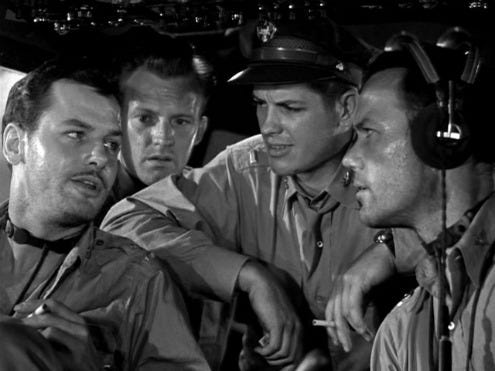Air Force (1943)

Written and shot in the heady days after Pearl Harbor, "Air Force" is a cheery bit of war propaganda that struck a chord with audiences when it was released in early 1943, less than 14 months after the surprise Japanese attack. The fictional tale of the intrepid crew of the B-17 "Mary-Ann" in the days before and after Dec. 7, 1941, it was a box office hit, earned a slew of Oscar nominations (including Best Screenplay) and became a rallying call for the war effort.
Seen today, though, it's a borderline cringeworthy drama in which American soldiers seem extraordinarily giddy about the prospect of near-certain death, coupled with some terrible special-effects miniatures that scarcely look better than cousin Johnny's toy planes and ships blown up with firecrackers.
Throw in some nasty anti-Japanese sentiment, virulent even by the standards of the time, and you've got a war film that has aged exceedingly poorly.
Perhaps most disturbing are several references put in during the Pearl Harbor attack scenes of "local Japanese" or "native Japanese" — aka Japanese-Americans — engaging in preplanned sabotage or attacks coordinated with the surprise air strike. Subsequent investigations proved that such claims were completely unfounded.
However, screenwriter Dudley Nichols (who received uncredited assists from Leah Baird, William Faulkner and Arthur T. Horman) cannot be entirely faulted for these harmful scenes, which doubtless contributed to the xenophobic paranoia that helped justify the mass internment of Japanese-Americans. They were working on the movie in the weeks and months after Pearl Harbor, with the script being altered on the fly to reflect the shifting realities of war.
As a result, a number of historical inaccuracies crept into the story — such as the B-17 crew flying to Manila when, in fact, U.S. troops in the Philippines retreated to Australia shortly after the outbreak of hostilities.
"Air Force" is named after the flying division of the U.S. Army, which didn't get split off into a separate military branch until after the war. Curiously, the studio chose to showcase the Mary-Ann as the real star of the picture despite a large and able cast of B-list stars and character actors.
John Ridgely plays the skipper, Capt. Michael "Irish" Quincannon, who's the perfect mix of inspiration and command. Gig Young (an Oscar winner for "They Shoot Horses, Don't They?") is the trusty co-pilot. Arthur Kennedy, who I'll always remember as the crusty journalist from "Lawrence of Arabia," is the bombadier. Charles Drake turns up as the navigator with daddy issues, George Tobias is the obligatory New Yawkah crewman and Harry Carey has a nice turn as the elder crew chief.
Rounding things out are James Brown as "Tex" Rader, a fighter pilot who enjoys a good-natured rivalry with the B-17 crew, and John Garfield as Winocki, the cynical gunner.
It's the familiar mix of characters you see in wartime movies, complete with the green young kid, etc. Winocki is the most interesting since he was a pilot trainee who got washed out of flight school by Quincannon a couple of years earlier and has a huge chip on his shoulder. His stint in the Army is set to expire three weeks after Pearl Harbor, but it doesn't take too many guesses to know he undergoes a change.
It's that insipid, familiar everybody's-a-swell-guy syndrome — except for the one not-so-swell guy, who later migrates in a swelltherly direction.
My biggest problem with the depiction of the American forces is that everyone's just so damn happy all the time! I quickly grew tired of all the aw-shucks smiles, playful bantering and men cracking jokes even as they know they're about to be overrun by the Japanese. One commanding officer of a tiny island, already grievously wounded, is offered a flight out on the Mary-Ann and refuses with, of course, a joke and a smile.
The combat scenes range from a few decent aerial sections to absolutely horrible. The miniatures of battleships and carriers at sea are entirely unconvincing as are the numerous shots of planes taking off and landing. There's just no weight to the images; we can sense the lack of immense inertia from these great steel beasts.
The stuff up in the air is better, with some actual dogfight footage spliced in with decent special-effects shots of enemy planes seen through the gunners' doors. We get a real sense of how a B-17 crew works together — the gunner on one side shouting out when a target is about to pass over to the other — and I can't help but think this movie influenced George Lucas when he was shooting the first "Star Wars" film.
War is terrible, but as seen in "Air Force" it's one great big smarmy smilefest with toy airplanes.
3 yaps



